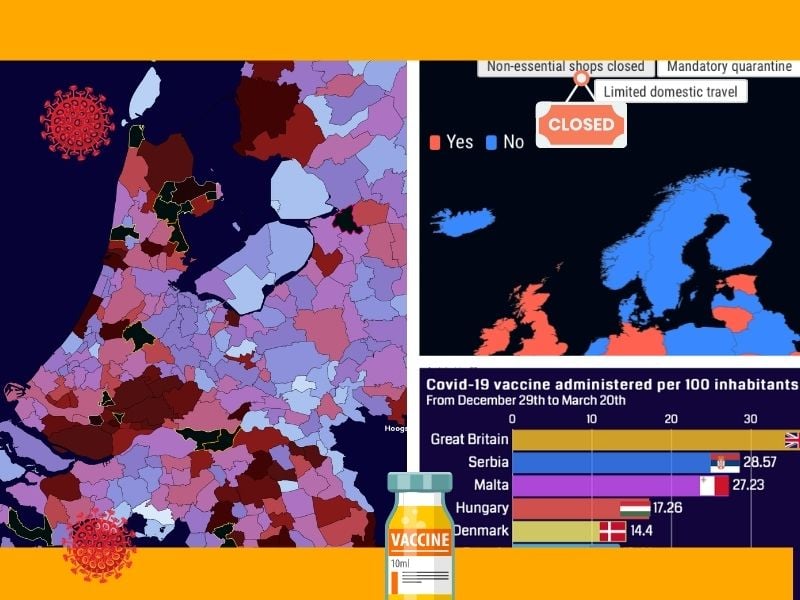
Exactly one year ago, European countries went into lockdown for the first time. The first wave rampaged across the continent in all its ferocity, and one head of government after another took tough measures to deal with the corona crisis. Has much has changed in the meantime? Quite a bit. But this is unfortunately not the case when it comes to restrictions or infection rates.
Because of the restrictions, the first two months of 2021 for most European countries – exceptions like Portugal, Ireland and Estonia – were relatively uneventful in terms of corona infections. This trend now seems to have come to a definite end.
This is primarily due to the spread of contagious variants. It also seems as if the virus has imposed a number of new ground rules on itself, which the existing restrictions are only able to deal with to a very limited extent. Consequently, the past month did not go particularly smoothly throughout Europe.
Inoculating against the clock
Although vaccination campaigns got underway at the beginning of the year, it is still too early to see the positive effect on a society-wide scale. Nevertheless, the number of hospitalizations among the very elderly has already decreased significantly. The virus is still spreading rapidly among the non-vaccinated part of the population. Along with all of its nasty consequences.
Italy reinstated lockdowns for several regions last week. The French capital Paris and nine other regions are also back under lockdown. While even the Swedish government has recently gotten its legislation in line to potentially use draconian policies in the future to reduce infections to acceptable levels.
In the Netherlands, the pandemic was pushed to the sidelines early on in March because of the general election. A number of measures were relaxed, presumably in order to appease the electorate. The result showed it was worth it: Victory went to the governing parties VVD and D66 with a clear lead. At the same time, the number of corona infections in The Netherlands went through the roof.
The following sliding charts, which compare last week with the week before and a month ago, speak volumes. The only good news lies in the proportion of positive tests, which fell slightly. Apparently, after more than a year of corona, the testing capacity is finally up to speed, more or less. Better late than never.
What about the vaccines?
Do vaccines help reduce the number of infections? They certainly do! But this requires a large majority of the population to be fully vaccinated first. Something that the Netherlands and other European countries still have several months of waiting ahead of them before this is achieved. Only a few percentage points of the population can call themselves fully protected against COVID-19 in the week before the end of March.
Also, the encouraging catch-up in speed that the Netherlands began last month does not seem to be taking hold. The number of vaccines administered per day has been declining for several weeks now, and the vaccination dashboard now states that ‘every 1.5 seconds. someone is injected.’ A few weeks ago, this was every 1.2 seconds.
It is not known why the pace is all of a sudden being slowed down. Still, the race amongst nations leaves little to the imagination. The Netherlands dropped in the rankings again in March and seems to be maneuvering towards the underclass, just like at the beginning of this year.
From European Vaccination Cup to World Vaccination Cup
That the EU countries will have to settle for a marginal role on the global playing field has been common knowledge for a number of months. More and more countries such as Chile, Morocco and Serbia have already got their operations well underway. In Israel, even more than half of the population has already been vaccinated.
Hungary has achieved a tremendous feat in terms of catching up. This is mainly because they have jettisoned the European Medicines Agency guidelines. Millions of vaccines from Russia and China have now arrived there.
This is evident from the infographic showing the global top 10, where Denmark no longer features either.

Danger not yet averted
Due to logistical hiccups, the tempo still leaves much to be desired. Also, difficulties with suppliers mean that there is no chance of an easing of restrictions within the short term. The Dutch government’s intention to open up the country more from April onwards has been put on hold again, just half a week after the elections.
That the coronavirus still causes a lot of misery after a year has been proven this month in the Czech Republic and Slovakia, where nursing staff had to be flown in from abroad to avoid the hospitals collapsing. In order to prevent this disaster scenario from happening elsewhere, more and more countries are opting for a new tightening of the current rules.
What precisely is allowed where? This series has a dedicated measures map for that purpose, which as of this week has been expanded to include non-essential stores that are open in one country and not in another. You can also use the buttons to search for other rules, such as travel restrictions, a curfew and quarantines that are mandatory in character.
Grueling last mile
Despite these somber reports, the overall trend is still optimistic. Although things could be a lot more expeditious and streamlined, the end of the corona pandemic is truly in sight. All that is needed for this is enough people who are immune. In a few months it really – but then really – should be over.
In Israel, where more than half the population has already been vaccinated twice, normal life has almost returned. All kinds of entertainment venues, restaurants and sporting events are accessible again without any corona rules. The only thing you need to have with you when you enter is a smartphone with your vaccination certificate. The infection figures speak for themselves.

